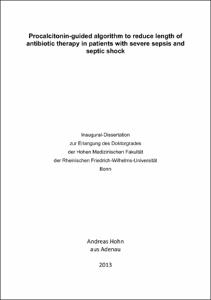Procalcitonin-guided algorithm to reduce length of antibiotic therapy in patients with severe sepsis and septic shock

Procalcitonin-guided algorithm to reduce length of antibiotic therapy in patients with severe sepsis and septic shock

| dc.contributor.advisor | Schröder, Stefan | |
| dc.contributor.author | Hohn, Andreas | |
| dc.date.accessioned | 2020-04-18T08:18:55Z | |
| dc.date.available | 2020-04-18T08:18:55Z | |
| dc.date.issued | 03.12.2013 | |
| dc.identifier.uri | https://hdl.handle.net/20.500.11811/5480 | |
| dc.description.abstract | Background: Procalcitonin (PCT)-protocols to guide antibiotic treatment in severe infections are known to be effective. But less is known about the long-term effects of such protocols on antibiotic consumption under real life conditions. This retrospective study analyses the effects on antibiotic use in patients with severe sepsis and septic shock after implementation of a PCT-protocol. Methods: We conducted a retrospective ICU-database search for adult patients between 2005 and 2009 with sepsis and organ dysfunction who where treated accordingly to a PCT-guided algorithm as follows: Daily measurements of PCT (BRAHMS PCT LIA®; BRAHMS Aktiengesellschaft, Hennigsdorf, Germany). Antibiotic therapy was discontinued if 1) clinical signs and symptoms of infection improved and PCT decreased to ≤1ng/ml, or 2) if the PCT value was >1ng/ml, but had dropped to 25-35% of the initial value within three days. The primary outcome parameters were: antibiotic days on ICU, ICU re-infection rate, 28-day mortality rate, length of stay (LOS) in ICU, mean antibiotic costs (per patient) and ventilation hours. Data from 141 patients were included in our study. Primary outcome parameters were analysed using covariance analyses (ANCOVA) to control for effects by gender, age, SAPS II, APACHE II and effective cost weight. Results: From baseline data of 2005, duration of antibiotic therapy was reduced by an average of 1.0 day per year from 14.3 ±1.2 to 9.0 ±1.7 days in 2009 (p=0.02). ICU re-infection rate was decreased by yearly 35.1% (95% CI -53 to -8.5; p=0.014) just as ventilation hours by 42 hours per year (95% CI -72.6 to -11.4; p=0.008). ICU-LOS was reduced by 2.7 days per year (p<0.001). Trends towards an average yearly reduction of 28-day mortality by -22.4% (95% CI -44.3 to 8.1; p=0.133) and mean cost for antibiotic therapy/ patient by -14.3 Euro (95% CI -55.7 to 27.1) did not reach statistical significance. Conclusions: In a real-life clinical setting, implementation of a PCT-protocol was associated with a reduced duration of antibiotic therapy in septic ICU patients without compromising clinical or economical outcomes. | |
| dc.description.abstract | Hintergrund: Procalcitonin (PCT)-basierte Algorithmen zur Steuerung der Antibiotikatherapie haben sich als effektiv erwiesen. Jedoch ist wenig über die Langzeiteffekte solcher Therapieprotokolle auf den Antibiotikaverbrauch unter klinischen Alltagsbedingungen bekannt. Diese retrospektive Studie analysiert die Effekte eines PCT-Algorithmus auf den Verbrauch von Antibiotika bei Patienten mit schwerer Sepsis und septischem Schock. Methoden: Nach Zustimmung der Ethikkommission erfolgte eine retrospektive Datenbankabfrage für erwachsene Patienten unserer operativen Intensivstation zwischen 2005 und 2009 mit den Kriterien Sepsis und Organdysfunktion. Daten von 141 Patienten mit schwerer Sepsis oder septischem Schock wurden in die Analyse eingeschlossen. Primäre Endpunkte waren: Länge der Antibiotikatherapie, Reinfektionsrate, 28 Tage-Mortalität, Länge des Intensivaufenthaltes, mittlere Kosten für Antibiotika (pro Patient) und Beatmungsdauer. Die primären Endpunkte wurden in einer Kovarianzanalyse (ANCOVA) für Effekte von Alter, Geschlecht, Simplified Acute Physiology Score (SAPS) II, Acute Physiology And Chronic Health Evaluation (APACHE) II Score und effektives Relativgewicht adjustiert. Ergebnisse: Ausgehend von 2005 nahm die Länge der Antibiotikatherapie bis 2009 von 14,3 ±1,2 auf 9,0 ±1,7 Tage jährlich durchschnittlich um einen Tag ab (p=0,02). Die Intensivverweildauer konnte jährlich um durchschnittlich 2,7 Tage reduziert werden (p<0,001). Die Reinfektionsrate wurde pro Jahr um durchschnittlich 35,1% (95% CI -53 bis -8,5; p=0,014) reduziert und auch die durchschnittliche Beatmungsdauer war pro Jahr um 42 Stunden (95% CI -72,6 bis -11,4; p = 0,133) rückläufig. Trends für eine reduzierte 28 Tage Mortalität von -22,4% (95% CI -44,3 bis 8,1; p=0,133) und Reduktion mittlerer Antibiotikakosten pro Patient von 407,6 ±57,2 Euro zu 373,9 ±83,7 Euro (p=0,495) waren statistisch nicht signifikant. Schlussfolgerung: Die Implementierung eines PCT-Algorithmus war unter klinischen Alltagsbedingungen bei septischen Intensivpatienten mit einer verkürzten Antibiotikatherapiedauer assoziiert ohne negative Effekte auf das klinische oder ökonomische Parameter zu haben. | |
| dc.language.iso | eng | |
| dc.rights | In Copyright | |
| dc.rights.uri | http://rightsstatements.org/vocab/InC/1.0/ | |
| dc.subject | Intensivmedizin | |
| dc.subject | Procalcitonin | |
| dc.subject | Sepsis | |
| dc.subject | Kosten | |
| dc.subject | Mortalität | |
| dc.subject | Intensive Care Medicine | |
| dc.subject | Costs | |
| dc.subject | Mortality | |
| dc.subject.ddc | 610 Medizin, Gesundheit | |
| dc.title | Procalcitonin-guided algorithm to reduce length of antibiotic therapy in patients with severe sepsis and septic shock | |
| dc.type | Dissertation oder Habilitation | |
| dc.publisher.name | Universitäts- und Landesbibliothek Bonn | |
| dc.publisher.location | Bonn | |
| dc.rights.accessRights | openAccess | |
| dc.identifier.urn | https://nbn-resolving.org/urn:nbn:de:hbz:5n-33375 | |
| dc.relation.doi | https://doi.org/10.1186/1471-2334-13-158 | |
| ulbbn.pubtype | Erstveröffentlichung | |
| ulbbnediss.affiliation.name | Rheinische Friedrich-Wilhelms-Universität Bonn | |
| ulbbnediss.affiliation.location | Bonn | |
| ulbbnediss.thesis.level | Dissertation | |
| ulbbnediss.dissID | 3337 | |
| ulbbnediss.date.accepted | 27.08.2013 | |
| ulbbnediss.fakultaet | Medizinische Fakultät | |
| dc.contributor.coReferee | Kalff, Jörg C. |
Files in this item
This item appears in the following Collection(s)
-
E-Dissertationen (1604)




